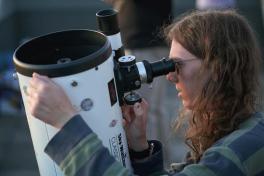(Buck)eyes on the Sky: Total solar eclipse places worldwide focus on astronomy

On April 8, 2024, millions of people across the United States shared an experience that only comes to this part of the world every few decades: a total solar eclipse. From large watch parties at national parks to small get-togethers in private backyards, humans in the path of totality took a break from regular life to watch the moon cover the sun and turn day into dusk. After such an experience, you may well wonder: what else is going on in the sky?
“The next eclipse that’s going to come through the U.S. is — well, if you want to go to Alaska, it’s in the 2030s,” said Wayne Schlingman, director of Ohio State’s Arne Slettebak Planetarium. “But if you want to get one in the contiguous United States, 2045 is the next big one. It cuts through Tennessee again, so we can all prepare for that. But that’s 20 years from now.”
In the meantime, the sun isn’t stopping the show anytime soon. Solar maximum, when the surface of the sun is particularly active, will occur over the next few years, meaning there will be more solar activity, more sunspots and even some northern lights as far south as Ohio and Arkansas. Schlingman recommended looking at space weather forecasts such as those available from the National Oceanic and Atmospheric Administration (NOAA) to plan for these events.

Ohio State’s Arne Slettebak Planetarium offers students the opportunity to present planetarium shows to the public and develop skills for future careers. Photo: Timothy Black
“If you want to learn more about astronomy, we have the planetarium on campus,” he continued. “We’re planning to have more public shows in the fall, and I’m working with the planetarium at Ohio State Newark to start up some night sky shows to learn how to find the bright stars and constellations.”
Additional central Ohio locations with a focus on astronomy include COSI in Columbus, as well as the John Glenn Astronomy Park in Hocking Hills and Perkins Observatory in Delaware.
“They have telescopes, they have evening programs, there’s a lot of really cool stuff down there,” Schlingman said. “You can see your fireflies, you can go hiking and then you can go stare at your stars and it’s really awesome. In the summer, you get that beautiful Milky Way because we’re looking towards the center [of the galaxy], it’s bright.”
